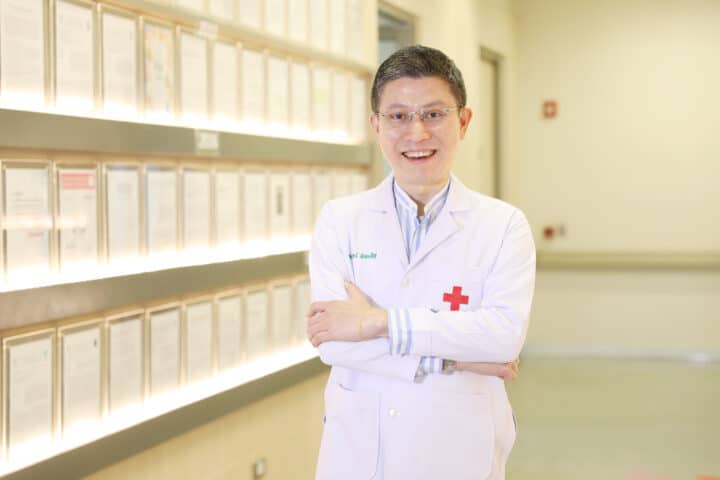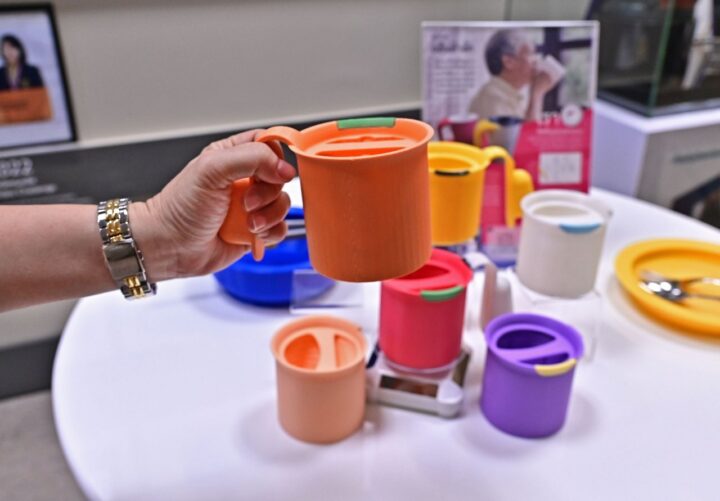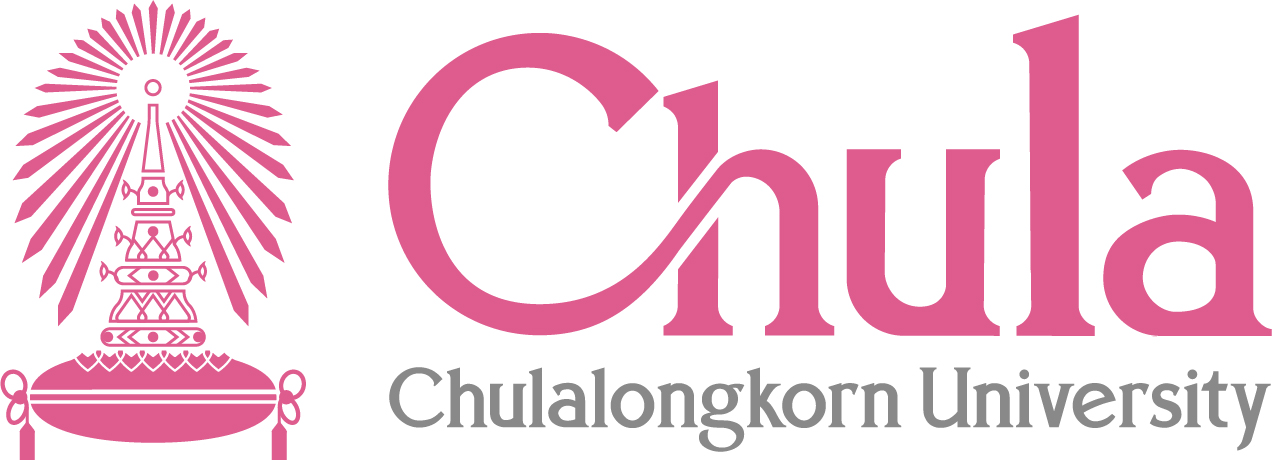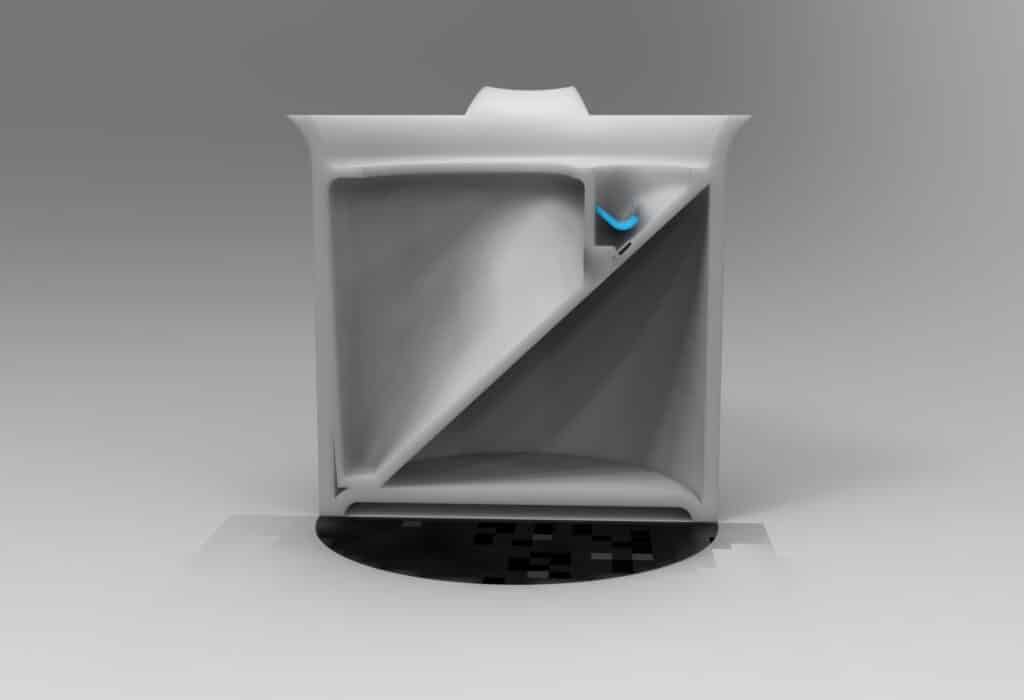Newswise — Choking is a potentially life-threatening problem, especially when it comes to older adults suffering from neurological diseases such as Parkinson’s, and Alzheimer’s diseases, etc. Choking in these patients can cause pneumonia, lung infections, sepsis, and eventually death, so it should not be overlooked by patients and caregivers.
“When patients with difficulty swallowing and are prone to choking come to see the doctor, the doctor would advise them to eat slowly, drink slowly, bend their neck, then swallow mindfully and practice their neck muscles regularly. This is easier said than done, as less than half of the patients can do this because we often eat and drink the way we’re used to, so much so that we run the risk of choking,” reflected Professor Roongroj Bhidayasiri, M.D., a neurology specialist, and head of the Excellence Center for Parkinson’s Disease & Related Disorders, King Chulalongkorn Memorial Hospital, Thai Red Cross Society.
“Since it is difficult for the elderly to modify their habits, we find other ways to help by studying normal drinking behavior. The act of lifting our neck when the water touches our lips is used as a basis for the development of the remarkable “anti-choke mug.”

Professor Roongroj Bhidayasiri, M.D.,
a neurology specialist, and head of the Excellence Center for Parkinson’s Disease & Related Disorders,
Choking – a dangerous symptom that should not be overlooked
People of any age can “choke” on their water and food, but this happens from time to time and is usually not very dangerous (if the symptoms are cured and help arrives in time). The choking that is worrisome and we should pay special attention to is the choking that occurs in the elderly who have weak neck muscles, and neurological patients whose muscles do not work properly, such as Parkinson’s patients and those with dysphagia (1 in 3 older adults, and half of brain patients have dysphagia).
“Some elderly people have difficulty swallowing and are at so high risk of choking that the doctor is at the point of prescribing placement of feeding tube through the nose or the abdomen, but most Thai families are afraid of doing so and the argument is often about pitying the elderly. Yet, this pity brings a very high risk,” Prof. Dr. Roongroj explains.
“One of the problems for the elderly is incomplete swallowing, and there is some food residue remaining in the oral cavity. For example, a morsel of food normally contains both rice and some other food, which the elderly or patients may not be able to swallow completely at once. Doctors usually advise the caregiver to tell the patient to swallow again for the second and third times to completely swallow the food. Moreover, the caregiver must also check in the patient’s mouth every time to see if there is any remaining food that may cause the patient to choke later.”
Delay aspiration may occur only a few minutes after swallowing, but it is also possible after an hour of eating.
Prof. Dr. Roongroj further illustrates, “It may seem like all the food has been swallowed, but in fact, there is still some food left in the mouth. When the patient lies on his/her back, the food bits could be dislodged, causing coughing and choking.”
Another type of choking is silence aspiration which refers to asymptomatic choking. There are no coughing or other symptoms, but small food particles or the patient’s saliva which has bacteria have already flowed into the windpipe (trachea), causing lung infection, or pneumonia. Patients will appear abnormal only when severe symptoms of lung infection manifest, such as cough, fever, difficulty breathing, and chest congestion leading to hospitalization.
How to Swallow Without Choking – Recommendations for Patients and Caregivers
Prof. Dr. Roongroj said that the care of patients with choking symptoms and dysphagia is a delicate matter. The caregivers must be calm and extra attentive in the following areas:
- Ask the patient to move the mouth and neck muscles regularly to strengthen them, for example, exercise the neck muscles by slowly bowing, tilting the head backward, and side to side, while holding in each position for 5 seconds, repeating 5 times; exercise mouth and lips muscles by pronouncing a: (aa), u: (oo), i: (ee), oʊ (o), ɪa (ai) sounds while holding each sound for 5 seconds, repeating 5 times, etc.
- Ensure that the patient is mindful of eating and drinking water, concentrating on eating and swallowing all the food. While eating and drinking, the patient should not talk, watch TV, or engage in other activities that distract them, and will reduce the effectiveness of swallowing, posing a risk of choking.
- Instruct the patient to bend his/her head while swallowing (chin tuck maneuver). Once the food is in the mouth, chew it thoroughly. When swallowing, tuck in the chin close to the chest before swallowing to reduce the chance of choking.
- Closely observe the patient’s eating behavior. If the patient shows signs of forgetting the advice, the caretaker should help guide the patient’s head at the right time so that the chin is tucked before telling them to swallow food.
Prof. Dr. Roongroj said that patients and caregivers receive such advice and practice from a swallowing trainer at the hospital, but oftentimes, when patients return home, their swallowing behavior goes back to their old ways.
“Most patients can only practice swallowing with a trainer at the hospital, and when they go home, they don’t adjust their eating habits according to the doctor’s instructions. Few patients can do this. In addition, some of the underlying diseases are obstacles, such as Parkinson’s disease, and those with strokes, muscle weakness, and arteriosclerosis that make swallowing more difficult.”
Anti-choke mugs – help ease swallowing, reducing the chance of choking
As behavioral changes for swallowing is difficult for both patients and caregivers, the research team then developed an “anti-choke mug” to help patients drink water safely.
“We designed an anti-choke mug so that users can drink and swallow water while the esophagus is in a good position, and the trachea is closed to reduce the risk of choking.”
Prof. Dr. Roongroj said the anti-choke mug is made with the same type of material as baby bottles, designed to look like a regular drinking mug with bright colors to stimulate users to want to drink more water.
“We don’t want users and people around them to feel that the person using this mug is a sick person in need of a medical device, so we designed the anti-choke mugs to blend in with everyday items that can be used anywhere,” Prof. Dr. Roongroj explained the concept design of the “anti-choke mugs.”
Though externally not different from regular mugs, the interior has a special mechanism to prevent choking that the research team has studied and calculated thoroughly — whether it is the angle and amount of water flow, and the appropriate duration for the water to flow from the mug to the user’s lips.
Prof. Dr. Roongroj explains the special features of the anti-choke mug, “This mug allows the elderly to drink without tilting their neck backward. And in so doing the chance of choking is drastically reduced. Most importantly, this anti-choke mug can ensure the appropriate amount of water per drink, and duration of drinking to make slow enough, and with the right volume, the right angle, the right drinking posture, and the right duration. These are things that will help reduce choking in the elderly and patients.” In addition, the anti-choke mug has a special design to help Parkinson’s patients.
“The handle of the mug is designed to have a bulging part at the bottom to help Parkinson’s patients who cannot grip properly, so that they can have a strong and stable grip, thus becoming more confident in drinking water.”

Prof. Dr. Roongroj further advised Parkinson’s patients with spasms and tremors that they should take their Parkinson’s medications before having their meals, drinking water, or doing various activities because when the medication starts working, the patient will have fewer tremors, move their body close to normal, and have reduced a chance of choking.
Real-world test of “anti-choke mugs” before production
Currently, the anti-choke mug is still a prototype that has past the preliminary research stage and is being tested with a large number of real users who are in-patients and outpatients who use the mugs in their daily lives. These mugs are fitted with sensors to monitor water drinking behavior.
“We want to know to what extent can drinking water from this mug in patients’ daily life without supervision from the doctor or nurse, can reduce choking. The results are all assessed from real usage data to make the design most compatible with everyday use, and then continue to expand production at the industrial level.”
In addition to the functional improvement, in this test phase, the research team will also address some of the limitations, especially regarding cleaning. Since the mug is designed in a single piece with an internal water barrier with a calculated sloping angle for an appropriate amount of water flow, it may be difficult to clean these nooks and crannies.
“Ultimately, the research team hopes that the “anti-choke mug” that we intentionally designed and developed will enable users to happily eat three meals a day, drink water with confidence, and not worry about choking,” Prof. Dr. Roongroj concluded.
Those who want to be part of the anti-choke mug research can contact Prof. Dr. Roongroj Bhidayasiri, the Excellence Center for Parkinson’s Disease & Related Disorders, King Chulalongkorn Memorial Hospital, Thai Red Cross Society, Sor Thor Building,
7th Floor, Tel. 0-2256-4000 ext. 70702-3, Fax. 02-256-4000 ext. 70704, Mobile: +668-1107-9999, Email: [email protected], Website: www.chulapd.org.



